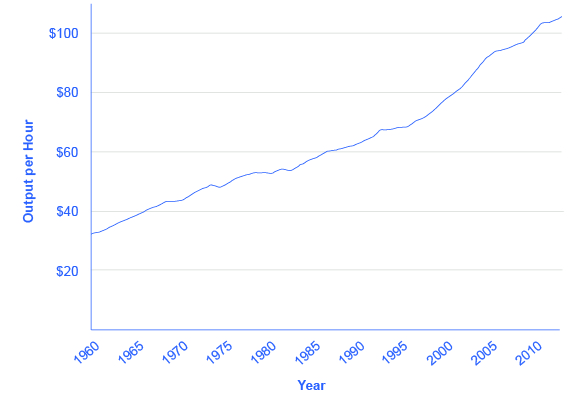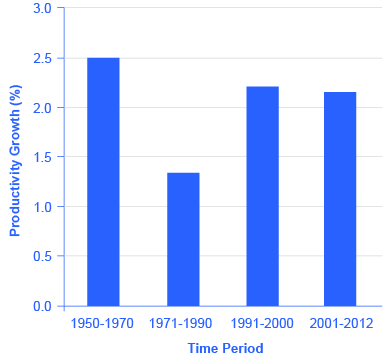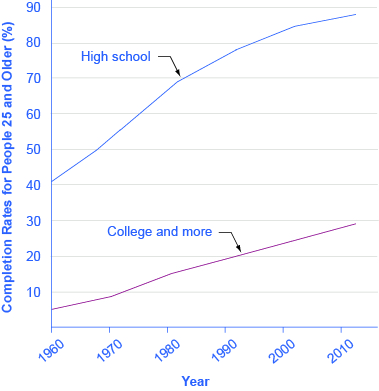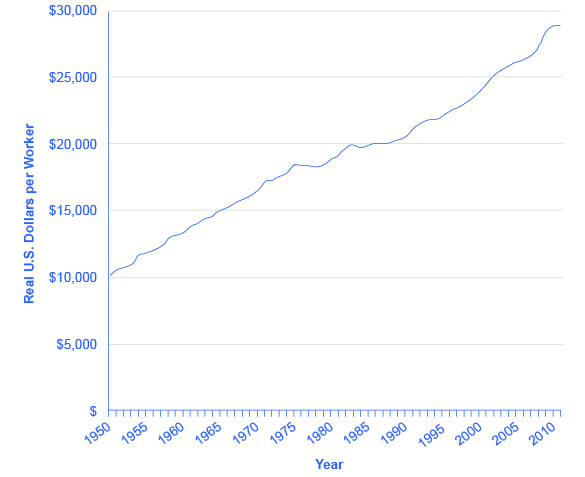Growth Accounting Studies
Since the late 1950s, economists have conducted growth accounting studies to determine the extent to which physical and human capital deepening and technology have contributed to growth. The usual approach uses an aggregate production function to estimate how much of per capita economic growth can be attributed to growth in physical capital and human capital. These two inputs can be measured, at least roughly. The part of growth that is unexplained by measured inputs, called the residual, is then attributed to growth in technology. The exact numerical estimates differ from study to study and from country to country, depending on how researchers measured these three main factors over what time horizons. For studies of the U.S. economy, three lessons commonly emerge from growth accounting studies.
- First, technology is typically the most important contributor to U.S. economic growth. Growth in human capital and physical capital often explains only half or less than half of the economic growth that occurs. New ways of doing things are tremendously important.
- Second, while investment in physical capital is essential to growth in labor productivity and GDP per capita, building human capital is at least as important. Economic growth is not just a matter of more machines and buildings. One vivid example of the power of human capital and technological knowledge occurred in Europe in the years after World War II (1939–1945). During the war, a large share of Europe’s physical capital, such as factories, roads, and vehicles, was destroyed. Europe also lost an overwhelming amount of human capital in the form of millions of men, women, and children who died during the war. However, the powerful combination of skilled workers and technological knowledge, working within a market-oriented economic framework, rebuilt Europe’s productive capacity to an even higher level within less than two decades.
- A third lesson is that these three factors of human capital, physical capital, and technology work together. Workers with a higher level of education and skills are often better at coming up with new technological innovations. These technological innovations are often ideas that cannot increase production until they become a part of new investment in physical capital. New machines that embody technological innovations often require additional training, which builds worker skills further. If the recipe for economic growth is to succeed, an economy needs all the ingredients of the aggregate production function. See the following feature about girl’s education in low-income countries for an example of how human capital, physical capital, and technology can combine to significantly impact lives.
Try It
In the early 2000s, according to the World Bank, about 110 million children between the ages of 6 and 11 were not in school—and about two-thirds of them were girls. In Bangladesh, for example, the illiteracy rate for those aged 15 to 24 was 78% for females, compared to 75% for males. In Egypt, for this age group, illiteracy was 84% for females and 91% for males. Cambodia had 86% illiteracy for females and 88% for males. Nigeria had 66% illiteracy for females in the 15 to 24 age bracket and 78% for males.
Whenever any child does not receive a basic education, it is both a human and an economic loss. In low-income countries, wages typically increase by an average of 10 to 20% with each additional year of education. There is, however, some intriguing evidence that helping girls in low-income countries to close the education gap with boys may be especially important, because of the social role that many of the girls will play as mothers and homemakers.
Girls in low-income countries who receive more education tend to grow up to have fewer, healthier, better-educated children. Their children are more likely to be better nourished and to receive basic health care like immunizations. Economic research on women in low-income economies backs up these findings. When 20 women get one additional year of schooling, as a group they will, on average, have one less child. When 1,000 women get one additional year of schooling, on average one to two fewer women from that group will die in childbirth. When a woman stays in school an additional year, that factor alone means that, on average, each of her children will spend an additional half-year in school. Education for girls is a good investment because it is an investment in economic growth with benefits beyond the current generation.
Try It
This question allow you to get as much practice as you need, as you can click the link at the top of the question (“Try another version of this question”) to get a new version of the question. Practice until you feel comfortable doing the question.
[ohm_question]152058[/ohm_question]
Learning Objectives
- [glossary-page][glossary-term]capital deepening:[/glossary-term]
[glossary-definition] an increase by society in the average level of physical and/or human capital per person[/glossary-definition][/glossary-page]





